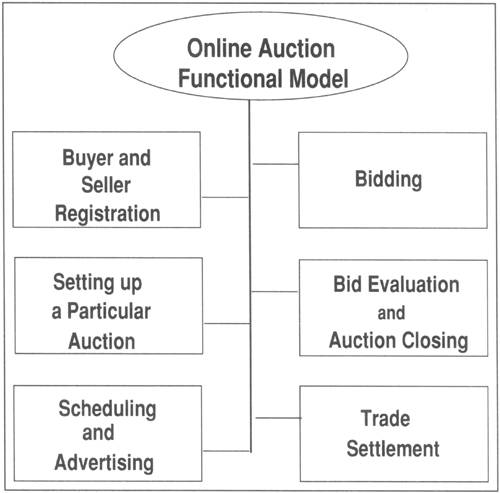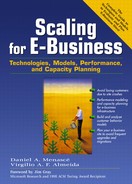1.3. Reference Models for Electronic Business
The reference model for electronic business, shown in Fig. 1.5, creates a framework for the quantitative approach developed in this book. It also provides a basis for defining conceptual activities in the electronic business and for identifying improvement opportunities. The reference model consists of four layers grouped into two main blocks. The upper block focuses on the nature of the business and the processes that provide the services offered by the electronic business site. The lower block concentrates on the way customers interact with the site and the demand they place upon the resources of the site infrastructure. Each layer of the reference model is associated with two broad classes of descriptors and metrics used to provide a quantitative characterization of the layer.
Figure 1.5. Reference Models for Electronic Business.

External metrics and descriptors cover the nature of the business and are visible to management and customers. These metrics are used to assess the performance of the business processes. For instance, one could use a metric for e-business that reflects at the same time the behavior of the online store and its customers. One such metric is revenue throughput, measured in dollars/sec generated by completed online transactions [10]. Other external metrics could be availability, download times, page views/day, and unique visitors/day. External descriptors give a quantitative overview of the business. For example, external descriptors include information such as the number of registered customers, number of potential customers, maximum number of simultaneous customers in the store, number of items, estimated operational cost, and services available to customers.
Internal descriptors and metrics characterize the site infrastructure and the way services and resources are used by customers. Internal metrics are oriented to measure the performance of applications and of the information technology infrastructure. Examples of such metrics include HTTP requests/second, database transactions/second, server response time, transaction response time, and processor, disk and network utilization. Internal descriptors also include application and architecture information, such as navigational structure, customer's navigation patterns, and characteristics of the components that make up the site.
1.3.1. Business and Functional Models
A business model [14][15] can be defined as an architecture for product, service, and information flow, including a description of business players, their roles, and revenue sources. For example, some of the most popular revenue-generating models adopted by companies are: i) charge fees for advertising, ii) sell goods and services, iii) sell digital contents, and iv) charge for processing the transactions that occur between two parties on the Web. There are several electronic business models, as exemplified by the following.
Online retailing. Electronic stores use the Web to sell physical goods (e.g.. books, CDs, computers, and clothing) to consumers. Sophisticated electronic catalogs, including pictures, detailed product descriptions, pricing, and sizing information, are available to customers.
Online auction. Electronic auction sites offer a variety of items that range from collectibles, such as antiques, sports memorabilia, coins, stamps, and books, to more general items, such as real state, airline tickets, and computers. In the most popular form of electronic auction, buyers and sellers can access auctions through an intermediary, i.e., an electronic auctioneer. Electronic auctions are a very popular way of selling and buying products. Their popularity is attributed to i) reduced search costs for the participants in electronic markets, ii) availability of a worldwide communication infrastructure with trading partners, and iii) availability of efficient search engines and diffusion of the WWW standard protocols and hypermedia representation of trade objects.
Content portal. Sites that are the major gateways to the Web or to a set of Web pages addressing specific topics are called portals. To attract traffic, portals provide value-added services to users, such as consistent interface to the Web, prioritization of links, and timely information.
Distribution. Some B2B sites provide components and production supplies. For example, in the industrial electronics market, online distributors offer products such as semiconductors, connectors, components, computer systems and peripherals, and production supplies.
Services. Many companies use the B2C model to sell services. Examples can be found in the travel, financial, banking, and insurance industries. Using their e-business sites, online companies offer services twenty-four hours a day, seven days a week.
Publishing. Newspapers, magazines, survey reports, and encyclopedias are examples of contents made available on the Internet by online publishing companies. Some companies charge subscription fees while others offer information for free and adopt advertising as the revenue-generating model.
Answers to the following types of questions help build a business model of an online company [13]. What is the purpose or mission of the business? What are the business goals? What are the measurable objectives? Is the electronic market open or is it restricted to certain groups? What is the potential size of the market? What business policies do participants follow? What are the revenue models? What value-added services offered to customers could be considered critical success factors?
The functional model depicts the trading processes that deliver services to customers of an electronic business company. The processes are sets of interlinked activities that directly deliver business outcomes. Functional models can be obtained from a top-down analysis of the electronic business. They can be represented by many techniques, such as process flow models, hierarchical activity models, data flow diagrams, and entity relationship models [15]. In the context of electronic business, the activities of a process can be further decomposed into services a customer can request from a Web site. Thus, a functional model provides the framework to identify the navigational structure of a site and to analyze different possible paths taken by customers.
Consider the case of XYZ, a Web-based auction company. Let us describe some information that would be part of the two upper layers of the reference model. Customers use the XYZ auctions to sell and buy items such as coins, stamps, CDs, pottery, glass, photography, computers, and electronics. Items are grouped into categories. There is no charge to browse, bid on, or buy items at the XYZ auction site. But sellers do pay fees to list and sell items. The XYZ trading site on the Web is available twenty-four hours a day and seven days a week and provides fast response time to any request. The business model of XYZ could be quantified by the following descriptors.
number of item categories: 1100;
number of new items "for sale" added daily to the site: 120,000;
number of auctions per day: 45,000;
number of registered users: 1.9 million;
number of page views per day: 4.8 million.
Figure 1.6 depicts the functional model of a typical online auction company with its six basic processes [8]. For instance, the "Bidding" process is responsible for collecting the bids from buyers and implementing the rules for the auction. In the case of a Dutch auction, the site lowers the starting price in each time interval until the first buyer bids. The functional model can be used as a starting point to design or identify the navigational structure of the auction site. For example, when a customer arrives at the home page, the site either authenticates the customer, using a login name and password, to initiate a secure session or offers the customer the opportunity to register with the XYZ company. After the registration or authentication step, the customer can visit typical pages such as 1) Browse, 2) Search, 3) Display Item Description, 4) Bid on an Item, 5) List Auction Rules, 6) Bid, and 7) Pay. From this functional model, one could draw representations for the navigational structure.
Figure 1.6. Functional Model of an Online Auction.

1.3.2. Customer and Resource Models
The two lower layers of the reference model are extensively treated throughout the book. Therefore, just a brief description of these layers is provided here. Customers interact with an e-business site through sequences of requests to execute the various services available at the site. The customer model captures the navigational pattern of a customer during a visit to an e-business site. This model describes how customers navigate through the site and allows one to derive behavior metrics such as how many times a certain function is invoked during a shopping session or the average length of a typical session. Each service requested by a customer exercises the resources of the e-business site infrastructure in a different way. Some services may use only the application server, others may request many operations from the database server. For example, a Display Product Information button of a multimedia catalog could require a large amount of network time and disk operations to send out large files of video and sound associated with the product. Thus, the performance of an e-business site depends on i) the pattern of services requested by customers, as described by the customer model, ii) the demands that each service places on the site's resources, and iii) the intensity at which customers arrive at the site.
The resource model combines these three aspects and calculates the site performance. In order to do that, the resource model contains two key elements: the workload model and the performance model. The former captures the pattern of services requested by customers and the demands that each service requires from the site's resources in terms of time. The workload model also characterizes the workload intensity as described by the customer arrival process within a representative time frame, such as the peak hours. The performance model is used to calculate performance metrics for an e-business site as a function of the site architecture and workload description. This model is used to compute metrics for different views of the site. Examples of resource usage metrics include processor utilization and average number of requests waiting for the database service. Higher level metrics, such as customer response time or site revenue per second, can also be obtained by the resource model.
